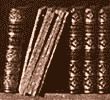|
Glossary
An excellent handbook for photographic terminology is Gordon Baldwin’s Looking at Photographs: A Guide to Technical Terms (Los Angeles: The J Paul Getty Museum, 1991) Albumen (negative): From 1848, a method of coating egg white mixed with light sensitive silver salts on glass. Low in sensitivity, which led to long exposures, but extremely fine in grain, which gave it life in specialised applications throughout the 19th century. Albumen (print): A printed-out paper common from about 1852 onwards. A solution of egg white was mixed with light sensitive silver salts and coated on paper. This provided a smooth, glossy printing surface, often toned with gold salts after processing to increase the permanence and to give a rich purplish-brown colour. Calotype: Sometimes called the Talbotype. A developed-out process almost always used for negatives. Discovered by WHFT in 1840 and patented and published in 1841. Developed with a solution containing gallic acid, it provided a negative on paper with an exposure time measured in seconds. The prints from these negatives were normally made on WHFT’s photogenic drawing paper but were sometimes erroneously called calotypes. Cliché Verre: First employed by WHFT in 1834 (without being named) but commonly associated with French artists of the 1850s and later. A negative was created manually by scratching through an opaque varnish layer coated on glass. This was then printed on light-sensitive photographic paper to make multiple final prints. Collodion: A mixture of guncotton dissolved in ether and alcohol, first used as a bandage for wounds — the solvents would evaporate quickly, leaving behind a tough clear film. In 1851, Frederick Scott Archer used this to adhere light sensitive silver salts on glass. Exposed and developed while still damp, the process was commonly known as wet collodion and produced a detailed negative in a relatively short exposure time. Later in the 19th century factory-made dry collodion plates were perfected. Later, it was used to make a printing paper. Cyanotype: Invented by Sir John Herschel in 1842. A mixture of dichromate and iron salts was coated on plain paper. Too slow for camera use, this paper could be exposed under a negative or more commonly under an object such as a botanical specimen. Wherever the light reached the coating a chemical change occurred, made visible as soon as the paper was placed in water. A characteristic deep blue colour resulted. Used later in the 19th century for amateur and field work as an inexpensive printing process and used well into the 20th century in the form of the architect's blueprint. Daguerreotype: Invented by Louis Jacques Mandé Daguerre and announced in 1839, this was the first process to take advantage of a latent image. A silver-plated sheet of copper was sensitised with the fumes of chlorine or bromine and exposed in the camera. When developed over the fumes of mercury, an amalgam was formed on the silver surface. Once fixed, this could be viewed by reflecting light off the plate. The unique image was structurally a negative but appeared to be positive in the right light. Developed-out process: An invisible latent image was formed by a brief action of light. A developer (normally a chemical) subsequently built this into a fully visible final image. Normally of most value in producing negatives, where it drastically shortened the exposure times. See also printed-out process. Fixing: In today’s parlance, the process of eliminating a photographic material’s residual sensitivity to light. Talbot originally fixed his papers with potassium iodide, potassium bromide or strong solutions of table salt. These converted the remaining unusued light sensitive silver salts into a relatively insensitive state; today these would be said to have been stabilised, for the salts remained in the paper. Herschel introduced hypo in 1839 as a ‘washing-out’ agent - it dissolved the remaining silver salts and allowed them to be removed from the paper. Today, the term fixing applies not to stabilisation, but rather to Herschel’s washing-out, and is still generally done with hypo. Photogenic Drawing: WHFT’s first photographic process, invented by him in 1834 and initially called sciagraphy. When announced in 1839, he called it as photogenic drawing, a term Herschel soon broadened under the umbrella of photography. Light sensitive silver salts were coated on plain writing paper. This could be exposed in a camera or directly in contact under an object such as a leaf. Where the light reached the surface, the energy reduced the salts to finely divided silver (see printed-out). This produced a negative (light produced dark) which could then be fixed. The same type of paper could be exposed under a negative to reverse things again, making a positive print. Photoglyphic Engraving: WHFT’s second major photomechanical process, patented in 1858. A gelatin and dichromate mixture was coated on a metal plate, dried, and then exposed under an object or a photographic positive. The coating was hardened wherever light reached it, forming a mask (or resist). The plate could then be etched with an iron solution, creating pits, and given a resin grain to retain intermediate tones. Once inked, it could be used to make multiple prints in a conventional press. Later perfected as the Talbot-Klic photogravure process. Photographic Engraving: WHFT’s first photomechanical process, patented in 1852. A gelatin and dichromate mixture was coated on a metal plate, dried, and then exposed under an object or a photographic positive. The coating was hardened wherever light reached it, forming a mask (or resist). The plate could then be etched with a platinum solution and washed. The pits that were created could receive printing ink and the plate printed in a conventional press. Printed-out process: The light sensitive silver salts are reduced to metallic silver solely by the action of light. This had the advantage of producing an immediately-visible image, but the vast amount of light required substantially extended exposure times. See also developed-out process. Talbotype: see Calotype Wet Collodion or Wet Plate: see Collodion
|


